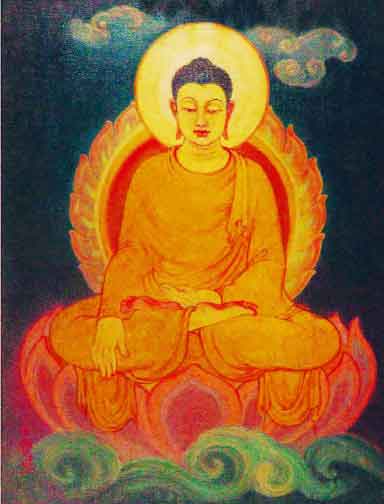Chitracharya Upendra Maharathi’s artworks represent a historic perspective and how it can be re-interpreted by an artist. By Uma Nair
Presenting a rare confluence of art and architecture, Chitracharya Upendra Maharathi presents a historic perspective through his paintings, drawings, murals, weaving, sculptures, and a stunning set of 24 chairs that talk about how the dynamism of design has evolved through the time.
National Gallery of Modern Art (NGMA) celebrates the newly renovated Jaipur House by unveiling more than a thousand works by Maharathi. The fact that 95 per cent of his works were bequeathed to the NGMA is a lesson in the annals of history. The artist was also a rare example of an individual who had deep interest in Buddhism. His designs spanned pagodas and other important ventures in Japan too.
Blending colonial and classic
As one enters the Jaipur House, tucked in the corner is a chaise-lounge characterised by a Baroque aesthetic that features elaborate turnings, simple curves as well as case pieces with simple flat surfaces and architectural trim. Maharathi commonly used materials such as indigenous teak to balance ebonising, elaborate carving, and elegant detailing. The chaise-lounge chair epitomises an eclectic combination of motifs and the simplicity of materials which has been loaned from the Buddhist monastery at Rajghirand. It was used by the monks to sleep upon.
Curator Adwaita Gadanayak, DG NGMA, has designed special installations all through the historic show for this retrospective entitled — Shashwat. He says, “Looking at the number of chairs, we realised that Maharathi had a conviction in the aesthetic experiences as a fully autonomous and independent aspect of a human life. His deeper philosophies followed the meshing of Indian and European ideals. For him, aesthetics stressed simple lines and naturalistic decoration, and he placed ornaments symmetrically.”
It wouldn’t be wrong to say that Maharathi moved beyond Gothic architectural details to give us architectural elements from the Mauryan as well as Magadha periods. His evolution, both in style and form, combines both Brahminical and Buddhist balance. His use of the legs, shaped in two curves, and various inlays, favoured over carved ornaments, reveals his love for small details. The Japanese-looking joineries that he saw on his visit to Kyoto talk of the creation of chairs without any nails. For Gadanayak, unveiling Maharathi is about visiting Indian history. And his works gifted to the NGMA form a resident resonance of a genius who needs to be studied.
Enriched by an epoch
Inspired by the epoch of the art and design period of Bihar during the Mauryan Empire and enriched by the folk and tribal culture, the quaint collection of chairs evokes an understanding of tradition and modernity through a classic vein.
Each chair unravels like its custom made by the artist, architect and designer himself. The weight distribution on the woven rope seats, comfort of the backrest, and the low slung silhouette look add to its charm. The smallest details have been worked upon for aesthetic as well as graceful syncopated reasons.The traditional jaali is as intricate as the plant inspired foliate designs.The Magadha symbol stands regal and royal.
Symphony of curves
The chairs that belong to the Maharathi Museum and the Buddhist Monastery are characterised by a sophisticated fluidity. When we group them they have a very strong and stylistic identity. In the symphony of elegant curves, these 24 chairs are a walk between private and public space.
Paintings and weaves
Other than the chairs, there are drawings, paintings portraits, woven shawl like sculptures and baskets woven with elan.
Among the portraits there is a frame designed by Maharathi himself which speaks of classic confluences. In his paintings he worked on canvas, paper, cloth and silk. Through his stunning Buddhist narratives, his deep understanding of spirituality comes to the fore. The softened contours show his passion.
Famous architectural assignments
Maharathi designed pagodas not only in India but Japan as well. The Gotemba Peace Pagoda of Japan that enshrines holy relics of Buddha was gifted by India in 1963. The Sanchi Style Gate at Gotemba Peace Park is another masterpiece there. According to his daughter Mahashweta Maharathi, both the monuments are situated in the foothills of Mount Fuji and are the third most visited peace parks after Hiroshima and Nagasaki.
In India, Rajgir World Peace Pagoda, built atop Ratnagiri hill, facing Gridhakuta hill, where Buddha preached the Saddharma Pundarika Sutra (Lotus Sutra) for eight years is of great fame.
He also designed the New Venu Van Vihara Monastery, which is located opposite to the ancient site of first Buddhist monastery presented to Buddha by Bimbisara. It was inaugurated in 1981. Of great importance is the Nav Nalanda Mahavihar (now under Union Culture Ministry at Nalanda) inaugurated by Vice President Dr Radhakrishnan in 1956. It was built to commemorate the ancient Nalanda University. The show affirms the truth that vintage and antiquities are finite, but an artist’s creativity is infinite.


























